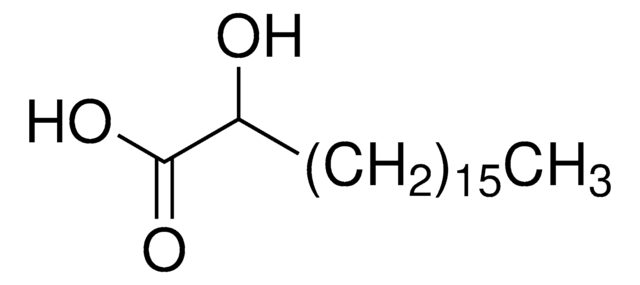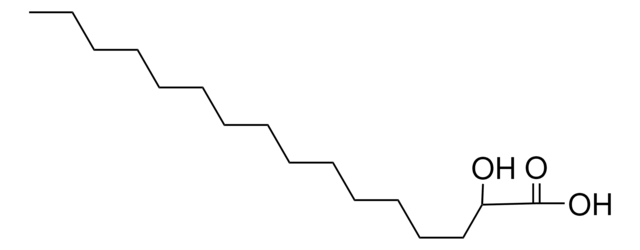SML0256
2OHOA
≥98% (HPLC)
Sinónimos:
(9Z)-2-Hydroxy-9-octadecenoic acid; cis-2-Hydroxy-9-octadecenoic acid, 2-Hydroxy Oleic Acid, Minerval
Seleccione un Tamaño
Seleccione un Tamaño
About This Item
Productos recomendados
Ensayo
≥98% (HPLC)
condiciones de almacenamiento
protect from light
color
white to tan
solubilidad
DMSO: >20 mg/mL
temp. de almacenamiento
room temp
cadena SMILES
CCCCCCCC\C=C/CCCCCCC(O)C(O)=O
InChI
1S/C18H34O3/c1-2-3-4-5-6-7-8-9-10-11-12-13-14-15-16-17(19)18(20)21/h9-10,17,19H,2-8,11-16H2,1H3,(H,20,21)/b10-9-
Clave InChI
JBSOOFITVPOOSY-KTKRTIGZSA-N
Aplicación
- a modulator of the sphingolipid and glycerophospholipid pathway to study its effects on myelination in mice Charcot–Marie–Tooth type 1A (CMT1A) myelinopathy and myelinating dorsal root ganglia cultures[1]
- in biophysical studies to study its effects on artificial membranes[2]
- to study its interactions with major membrane lipid films[3]
Acciones bioquímicas o fisiológicas
Palabra de señalización
Danger
Frases de peligro
Consejos de prudencia
Clasificaciones de peligro
Eye Dam. 1
Código de clase de almacenamiento
11 - Combustible Solids
Clase de riesgo para el agua (WGK)
WGK 3
Punto de inflamabilidad (°F)
Not applicable
Punto de inflamabilidad (°C)
Not applicable
Elija entre una de las versiones más recientes:
Certificados de análisis (COA)
¿No ve la versión correcta?
Si necesita una versión concreta, puede buscar un certificado específico por el número de lote.
¿Ya tiene este producto?
Encuentre la documentación para los productos que ha comprado recientemente en la Biblioteca de documentos.
Los clientes también vieron
Active Filters
Nuestro equipo de científicos tiene experiencia en todas las áreas de investigación: Ciencias de la vida, Ciencia de los materiales, Síntesis química, Cromatografía, Analítica y muchas otras.
Póngase en contacto con el Servicio técnico













